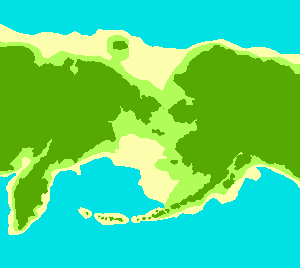Thousands of years ago, a vast land bridge called Beringia connected two continents, shaping the course of human history. Imagine early hunters crossing this icy expanse in search of survival, unaware they were paving the way for the first Americans. How did they endure such harsh conditions, and what secrets does Beringia still hold?
What Was the Bering Land Bridge
Evidence suggests that the first humans crossed this “land bridge” at least 20,000 years ago, and possibly even earlier. These early hunters used the land bridge to migrate into new regions during a time when the Earth’s climate was much colder.
Today, the Bering Strait separates Asia and North America by more than fifty miles of ocean. During the Ice Age, however, these continents were connected by a massive strip of land stretching over 1,000 miles wide.

The coastline of Beringia during the last Ice Age.
Life During the Ice Age
Beringia existed during the last Ice Age, a period when the Earth’s climate was much colder than it is today. During an ice age, precipitation that fell on land froze into massive sheets of ice called glaciers. As glaciers grew, they trapped large amounts of ocean water, causing sea levels to drop by about three hundred feet.
Today, scientists worry that human activity is making the Earth warmer, which is causing polar ice caps to melt. This melting could raise sea levels and flood coastal areas.
Although the climate of Beringia was extremely cold, it seems to have been warmer than nearby regions are today. Beringia remained free of ice because the area received very little snowfall. Instead, it was a grassland scattered with small trees, which provided food for large animals like bears, bison, and the now-extinct woolly mammoths and mastodons.
These animals attracted human hunters to Beringia. The first hunters likely crossed into North America in small groups, starting about 40,000 years ago.
As the climate warmed, glaciers began to melt. Rising sea levels gradually submerged the land bridge about 15,000 years ago—at least 9,000 years before civilizations emerged in Egypt, Mesopotamia, and China. Today, more than 50 miles of ocean separate Asia from North America.
How Did the First Americans Arrive
Some scientists believe the first Americans could have arrived by sea, following the coastline of the Pacific Rim of northeastern Asia and Beringia to as far south as South America. They suggest the waters of most of the route contained forests of edible seaweeds called kelp. In addition to being nutritious, kelp supports fish and other sea life that could have sustained early explorers. It is difficult to prove the “kelp highway” theory correct because rising sea levels would have submerged any evidence left behind by the explorers. Still, it might help to explain ancient skeletal remains found primarily in South America that do not fit the profile of the people who passed through Beringia.
Another theory suggests that some migration to the Americas might have come from the Polynesian Islands in the Pacific, possibly by sailors who were blown off course. To explore this idea, adventurer Thor Heyerdahl built a raft in 1947 using materials and techniques believed to be available to ancient peoples. Heyerdahl and his crew of six sailed 3,770 miles on the Kon-Tiki, a raft named after an Inca god. Their 97-day journey took them from Peru to Puka Puka, a small island in the South Pacific. This demonstrated that ancient sailors could have navigated the vast Pacific Ocean.
Kon-Tiki
Kon-Tiki was the raft used by Norwegian explorer and writer Thor Heyerdahl in his 1947 expedition across the Pacific Ocean from South America to the Polynesian islands.
The Inuit, traditionally called Eskimos by outsiders, reached America from Asia long after the land bridge had disappeared. They crossed the icy waters of the Bering Strait in boats between 6000 and 2000 BCE. DNA evidence shows that the Inuit are genetically distinct from other indigenous peoples of the Americas.
Our understanding of the Bering Land Bridge and early human migration is always changing. New discoveries suggest that people may have used the land bridge earlier and during different times than scientists once believed. These findings remind us that history is like a puzzle, and each new piece helps us see a clearer picture of how humans adapted to their world and found new places to live.
Resources
Download this lesson as Microsoft Word file, a Google doc, or as an Adobe Acrobat file.
View a Powerpoint presentation of this lesson.
Listen as Mr. Dowling reads this lesson.
Norwegian adventurer Thor Heyerdahl (1914 – 2002) sailed 5,000 miles across the Pacific Ocean in the Kon-Tiki. Heyerdahl’s expedition demonstrated that long sea voyages were possible in ancient times.
